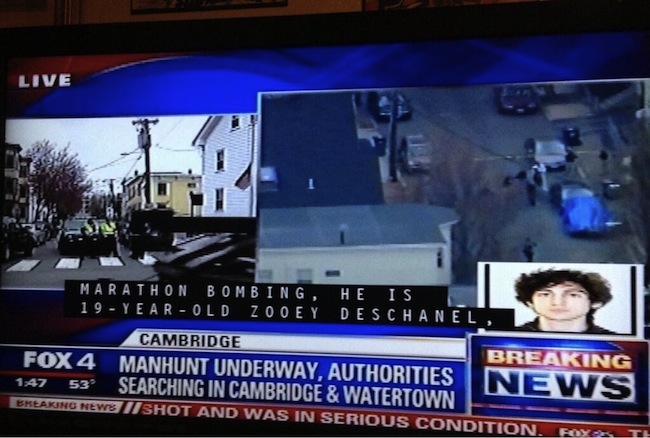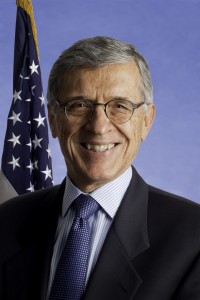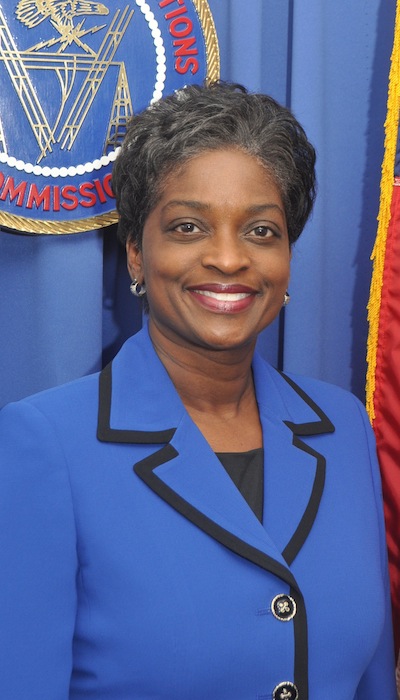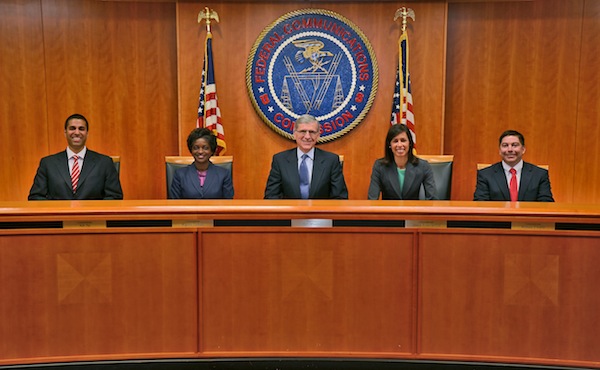Click here to print
FCC Announces New “Rules” for Closed Captioning
posted February 22, 2014
A key question remains: Will the “rules” turn out to be just another case of ignored FCC recommendations?
n
If you think the subtitles to foreign movies are often askew, try being hearing-impaired to the degree that you need to read the renditions of statements that “closed captioning” provides.
It is not good enough, according to Tom Wheeler, the recently appointed chairman of the Federal Communications Commission. And that is a fundamental failure of the telecommunications industry and federal regulators, he implied: “Reliable and consistent access to news and information for deaf and hard-of-hearing communities is a right,” he said in a statement as the FCC adopted new rules on Thursday 20 February 2014 that will require broadcasters to perform much better in the closed captioning they provide.

Bungled captions may seem amusing — although not, in this case, to Zooey Deschanel — but advocates of better rendition of speech to text on television point out that errors relating to, say, natural-disaster emergency plans can endanger the lives of people with hearing impairment.
The issuing of new — in reality, refreshed — rules was well overdue, said one commissioner, Jessica Rosenworcel, a communications-law expert. Captioning quality has been “uneven” and enforcement “limited,” she said. “So a decade ago a group of advocates representing individuals who are deaf or hard of hearing filed a petition for rulemaking and asked us to fix these problems. That is what we do, at long last, today.”
She emphasized how important the Commission viewed the issue to be. It was “finally making good on the promise that television programming should be understandable to the non-hearing person as it is to the person who can to hear,” she said. “Our actions will improve television accessibility for the estimated 36 million Americans who are deaf or have hearing loss — and the 40 million Americans over the age of 65 who experience varying degrees of hearing loss at some point in their lives. “

Chairman Tom Wheeler. FCC photo.
The FCC’s efforts to push closed captioning began in July 1993, when it required all American-made and –sold analog television receivers with screens 13 inches or larger to contain built-in decoder circuitry to display closed captioning.
The Telecommunications Act of 1996 required video programming distributors — whether cable operators, broadcasters, satellite distributors, or other multi-channel video-programming distributors — to make the changes, but organizations that advocate for the deaf and hearing impaired have long complained that enforcement was so lax that captioning remained rare until the 1990s. The law did not apply to home videos, DVDs, or video games. (The first use of closed captioning is murky only because an earlier format, open captioning, debuted in 1972 with a Julia Child cooking program on PBS, while closed captioning debuted 16 March 1980 with a broadcast of The ABC Sunday Night Movie, Disney’s Wonderful World on NBC, and Masterpiece Theatre on PBS, according to one history of the practice or another.)
In 1997, the FCC set a transition schedule requiring distributors to increase their proportion of captioned programming. From 1 July 2002, the Commission also required that digital television receivers include closed-captioning display capability. In an effort to keep up with a changing world of broadcasting, the FCC in October 2012 told distributors of some Internet video programming that they, too, would have to provide closed captioning “pursuant to the Twenty-First Century Communications and Video Accessibility Act of 2010,” the CVAA, which President Barack Obama in October 2010. The rules applied primarily to television programming that is little changed before being posted to the Internet.

Commissioner Mignon Clyburn. FCC photo.
At the 20 February 2014 release of new rules, one FCC commissioner, Mignon L. Clyburn, said that due to developments in telecommunications since the 1996 Act, “today, it is only right and just that we refresh those rules to reflect the technological and societal changes which have transpired.” Clyburn, a former weekly-newspaper publisher known for her advocacy of consumer rights, particularly for the deaf and other Americans with disabilities, added: “The deaf and hard of hearing community has waited a long time for the Commission to play catch up and address some basic concerns, which seemed to have gone unheard since the captioning rules were enacted.”
Despite its slowness in enforcing the laws and rules, the Commission has long touted closed captioning on its own website as an important aid for deaf and hearing-impaired television viewers, as well as non-English speakers who may be helped by being able to read captions as they hear English speech.
The new rules reemphasize and require what closed captioning has always been asked to do: Captions must accurately render and match spoken words, and also provide a sense of what sounds are present in audiovisual works. Captions must be displayed such that they do not obscure the visual content, nor overlap other captions, nor run off the edge of the screen or into conflict with other writing included in shots.
The rules will be more stringent for entertainment programming and other programs than for on-the-fly news and sports telecasts. But now, said the FCC ruling, it is calling for more “pre-scripting” of news programming related to sports, weather, and even late-breaking news broadcasts, so that closed captioning also could be more widely possible. In addition, the new rules make increased demands on news segments that cannot be pre-scripted: they require increased use of “crawls” — text that moves across screens rather than appear as still captions — and other visual information.
The FCC said its expanded rules relate to accuracy, synchronicity (timing), program completeness, and placement of closed captions. In addition to matching dialogue and conveying other sounds, captions will have to better coincide with spoken words and sounds and be displayed at a legible speed. As much as possible, they must run from the beginning to the end of programs, and be placed on the screen with more consideration of text already included in the broadcast footage.
Some types of broadcast will continue to be permitted not to include closed captioning. Among those are public-service announcements not paid for with federal money; early-morning programming; and programming that is primarily textual, to begin with. In addition to such “automatic exemptions,” broadcasters will continue to be able to petition for exemptions on such grounds as that captioning would be too costly.
Reducing broadcasters’ need to petition will be that the rules do not specify how much of an increase in captioning must be achieved. Instead — how effectually remains to be seen — it outlines “best practices for video programmers and captioning vendors.” For example, video programmers are encouraged to provide high-quality audio so that transcriptions can be more accurate. They can provide captioning vendors in advance with scripts, proper names, and song lyrics. Vendors can better train and supervise their captioners and monitor the stability of their captioning.
Commission chairman Wheeler, a cable, wireless, and video-communications entrepreneur who is the only person to be elected to both the Cable Television Hall of Fame and The Wireless Hall of Fame, began as FCC chairman in November 2013, and has been forthright in his advocacy of captioning; he has scolded the agency for taking 10 years to get little done to improve captioning.
While the FCC has over the years said it would more energetically enforce its captioning rules, that has not much done. For their part, broadcasters seem simply to have shirked their responsibilities, rather than struggled with technological requirements.
The new rules seem, for example, to fall short of recommendations made in July 2011 in a report from the Video Programming Accessibility Advisory Committee, an FCC panel of technical and engineering experts that was created as one stipulation of the Twenty-First Century Communications and Video Accessibility Act of 2010. The committee’s charge was to report on what improvements could realistically be expected of broadcasters, and its report called for the creation of new rules within 6 to 18 months — by January 2012 and January 2013, rather than February 2014 — depending on whether the programming was prerecorded and unedited for Internet distribution, live or near-live, or prerecorded and substantially edited for Internet distribution. That report recommended what broadcasters should achieve in terms of performance objectives, technical requirements, and technical capabilities and procedures related to closed captioning on the Internet. And it discussed new technological developments such as emerging protocols and other innovations that could shape future Internet delivery of closed captioning.
In a statement of its 20 February 2014 changes, the FCC put a shine on its role, saying “today’s action resolves decade-long concerns” and “provides much-needed guidance” to distributors and programmers. “Resolves” appears an overstatement; even FCC Chairman Wheeler said: “This remains a work in progress. For example, I recognize that consumer groups are skeptical about whether the enhanced Electronic Newsroom Transcript procedures will be sufficient. At the same time, distributors and programmers are concerned about whether a single complaint might lead to unreasonable fines. With this accord, however, both have said, ‘Let’s give it a try.’”
Some programmers have echoed that can-do stance by finding low-cost workarounds. Those echo the spirit of two books Wheeler has published: Take Command: Leadership Lessons of the Civil War (Doubleday, 2000) and Mr. Lincoln’s T-Mails: The Untold Story of How Abraham Lincoln Used the Telegraph to Win the Civil War (HarperCollins, 2006). Advocacy groups may also take heart from Wheeler’s record as a former Chairman and President of the Foundation for the National Archives, and a former board member of the Public Broadcasting Service (PBS).
![FCC Commissioner Rosenworcel, Jessica [ FCC Official Photo ]](http://www.movingimagearchivenews.org/wp-content/uploads/2014/02/Rosenworcel.jpg)
Commissioner Jessica Rosenworcel. FCC photo
While key advocacy groups have yet to voice their response to the new rules, which might more properly be called guidelines, they struck a conciliatory tone during public meetings with FCC commissioners, and some seemed likely to maintain that stance. For example Michael Powell, the president of the National Cable & Telecommunications Association, and a former FCC chairman, said in a statement: “The cable industry is committed to providing high-quality captioning to our customers and we would like to thank Chairman Wheeler for his thoughtful approach to this important issue.” The FCC’s statements of best practices “will help advance our common goal,” he said.
— Peter Monaghan
Printed from Moving Image Archive News: http://www.movingimagearchivenews.org
URL to article: http://www.movingimagearchivenews.org/fcc-announces-new-rules-for-closed-captioning/
Click here to print
